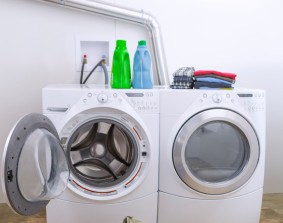Don’t have room for a washer and a dryer in your small laundry room? A washer/dryer combination is one machine that washes and dries clothes all in the same unit. This product is relatively new in the U.S. market, and it offers twice the performance in about half the space of a traditional, side-by-side set-up.
This handy all-in-one appliance is not the same as the stackable units you might see with a washer on the bottom and a dryer on top. In fact, a combo unit looks a lot like an ordinary dryer, since it’s about the same size and even has a round door on the front that opens to the inner chamber where the clothes go.
Special settings can include delicates, timed drying and extra rinse. Some units offer a special steam-wash feature that can do a number of things, such as upgrading the machine’s ability to whiten laundry without bleach, reducing wrinkles and improving the washer’s overall performance. But how does it compare in efficiency to regular washer/dryer sets?
If you’re in the market for a new washer and dryer, you might want to check out the next page. Find out some facts about washer/dryer combos and how energy efficient they really are.
Combo Machine Considerations
There are a handful of things to consider when purchasing a washer or dryer, such as price, size and efficiency.
Combo machines range from less than $500 to more than $1,500. Washers and dryers sold separately start at around the same price, but they can cost up to several thousand dollars each. As with anything, you get want you pay for. In a 2010 study, most top-loading washers that cost less than $500 failed to wash as well or hold as much as more costly washers, and they also used more energy and water. The study also found that inefficient machines, compared with the most efficient models, can cost an additional $130 or more per year to run [source: Consumer Reports]. So what does this mean for you?
Take your plans for the future into consideration when choosing a washer/dryer combo. For example, if you intend to move relatively soon and don’t plan to take your appliances with you, perhaps you can save money by skipping a high-end model for one at a cheaper price point. And if you plan to keep this appliance until the day it dies, it’s probably best to buy a better-quality model that costs more because of the savings it offers over time.
Just like in traditional units, the tub inside a combo machine can vary in size from small to industrial, and many models come in a variety of colors, including stainless steel, champagne and cherry red. One big difference, however, is that because washer/dryer combos are relatively new to the U.S. market, fewer stores carry them, so you might have a hard time getting your hands on one.
There’s a lot of marketing out there claiming that washer/dryer combos are energy-efficient. To learn how efficient they really are, click to the next page.
Are combo machines energy efficient?
To find out how efficient your machine is, there are several things to consider. First, there are two kinds of washer/dryer combination machines: vented and ventless. The first essentially works like a standard side-by-side washer and dryer. The washing cycle involves laundry that’s whirled around in soapy water, rinsed, then spun with heated air. The generated steam leaves the unit, and your home, through a vent.
Of course, a ventless washer/dryer combo doesn’t have a vent or exhaust shoot. It differs mostly in regard to how it dries clothes. A condensing chamber is cooled, and air in the drum (where the wet clothes are) is heated. When the drum spins around, this warm air retains moisture, which gets kicked through the condensing chamber. Here, the moist air cools and turns into water, leaving the machine through a pipe. Laundry can feel a bit damp even after the cycle is done. You can help maximize efficiency by not overloading the machine or by removing clothes after the dry cycle to finish drying them outside of the unit.
When it comes to overall efficiency, over the last 10 years, washers have become more efficient while dryer technology hasn’t changed significantly [source: Consumer Reports]. This means that some combo units can be more energy-efficient than two separate standard machines.
The enhanced energy efficiency of combo units comes down to their reduced hot water usage and washer mechanics — the stainless steel drum spins faster than ever (up to 1,000 rotations per minute) sucking more water out of the laundry. A family of four can save about $100 each year on laundry utilities using a combo machine, thanks to its reduced use of energy and water [source: NAHB Research Center].
So, ultimately, many washer/dryer combination machines can be counted as energy-efficient appliances. A handful of combo machines meet ENERGY STAR and Consortium for Energy Efficiency standards, and these models are among the most energy efficient. You can also look for a black and yellow EnergyGuide label. The Federal Trade Commission requires that all combo units display this sticker, which will tell you the machine’s energy use. Keep in mind that this sticker only rates the unit’s energy use against other compact, front-loading washing machines, not against the average capacity of top-loading machines.
Source: Surina, Echo. “Are washer/dryer combination machines energy efficient?” 05 October 2010. HowStuffWorks.com. <http://home.howstuffworks.com/appliances/energy-efficient/washer-dryer-combination-machine-energy-efficient.htm> 12 May 2014.
